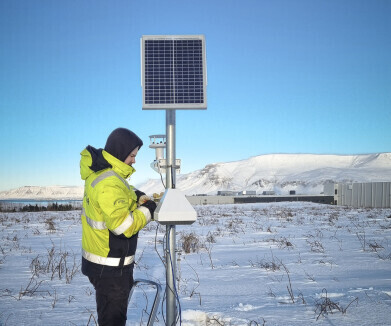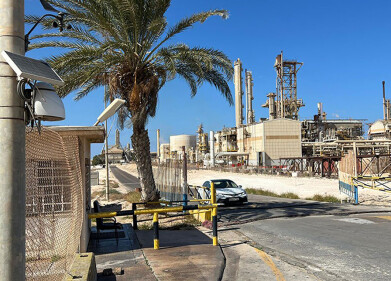Air Quality Monitoring
Supporting your air quality monitoring system when you can’t get to it
May 07 2024
Each time we think we have found a spectacularly remote monitoring location, an even more inaccessible spot is reported by one of our users. Full-day trips to visit a location have now been beaten by customers who need to charter a plane to reach them. So, remote diagnostics and support are very important.
Luckily, IoT communications, cloud data management and over 10 years of experience supporting AQMesh have allowed us to continually improve our ability to supply and support AQMesh in remote locations. Pods have been used from the edges of the arctic to undeveloped deserts - as well as on ships - with the help of a few features.
Robust design, low maintenance intervals
AQMesh was designed to be rugged, for use all over the world and with an expected maintenance interval of two years. We have always understood that field maintenance requirements must be kept to a minimum, and pods operating for year after year, in the harshest environments - from deserts to extreme cold - demonstrate design effectiveness. This includes protecting electronics from the elements and mitigating electromagnetic interferences, as well as taking measures to keep insects, wildlife and birds out/off. The unobtrusive pod design has also ensured a very low rate of vandalism and theft.
QA flags and notifications
The AQMesh data stream includes vital pieces of information which allow users and the AQMesh support team to check that pods are functioning correctly and provide an early warning system. Users can register for email notifications for their pods - it is always better to find out that power is running low or data is no longer being transmitted at the time, rather than when the project ends and it’s time to review data.
Remote scaling / calibration
Whilst AQMesh was a leader in co-location comparison and the ‘gold pod’ technique for in-field calibration, these approaches do require regular site visits to move pods around. We have now developed a method that can provide remote calibration of a sensor network, with or without an available reference station, that does not rely on artificial intelligence.
Diagnostic information
The AQMesh team can access additional diagnostic information remotely, such as performance indicators from the optical particle counter, solar pack battery voltage or sensor failures. Some of these indicators are available to users via their secure online or API access, and some can be used by our global technical support team. The team uses the full range of diagnostic information available, including SIM connection attempts, to provide free support for the life of the equipment. Their over-riding goal is to fix any problem without asking users to visit the site.
Over the wire intervention and updates
AQMesh firmware developments now allow power cycles to be triggered remotely, firmware to be updated over the wire or remote sampling and transmissions interval changed.
Power
We have learned from the many challenges that power supplies can present to remote operation. Whilst the original lithium thionyl chloride battery offered unbeaten long-term autonomous operation of gas sensors, increasing shipping limitations have turned our focus to direct power supply and solar. We invested in a full technical investigation to identify a mains to 12V DC transformer that could cope with ‘dirty’ power supplies, as well as in-pod measures to manage spiky or intermittent power.
Having seen so many problems from simple solar-panel-plus-battery arrangements, we designed our own smart solar pack, which squeezes the most power out of any location, manages power delivery and provides online voltage measurements. We are mindful that sampling and reading rates are defined by the project – and potentially certification – and the power supply must deliver the same sampling throughout the year. Readings should not be compromised by the difficulty of providing autonomous power.
Communications
The global SIM supplied with a standard AQMesh pod will roam across networks to find the best connection at each transmission, and has proven to be a very reliable way of transferring sensor output from hardware to our cloud server for over 10 years in more than 70 countries. Occasionally, we find that only a single, specific network is available – or a customer would prefer to use their own SIM – in which case we can programme the pod to work with a locally-sourced SIM contract. To achieve autonomous communication, the AQMesh LTE CAT M1 modem uses the latest LTE communications standard, including support for NB-IoT where available. In the most extreme cases, satellite communication is the only viable option and AQMesh can connect via an ethernet port to a suitable modem to connect this way. Reliable communications are key to remote data access and support.
The growing need for remote, long-term monitoring, in all conditions, drives our continuous development from data QA to comms, and we welcome challenges.
For more information please visit the website.
Digital Edition
AET 28.4 Oct/Nov 2024
November 2024
Gas Detection - Go from lagging to leading: why investment in gas detection makes sense Air Monitoring - Swirl and vortex meters will aid green hydrogen production - Beyond the Stack: Emi...
View all digital editions
Events
Jan 12 2025 Abu Dhabi, UAE
Jan 14 2025 Abu Dhabi, UAE
Jan 20 2025 San Diego, CA, USA
Carrefour des Gestions Locales de L'eau
Jan 22 2025 Rennes, France
Safety, Health & Wellbeing LIVE
Jan 22 2025 Manchester, UK



















